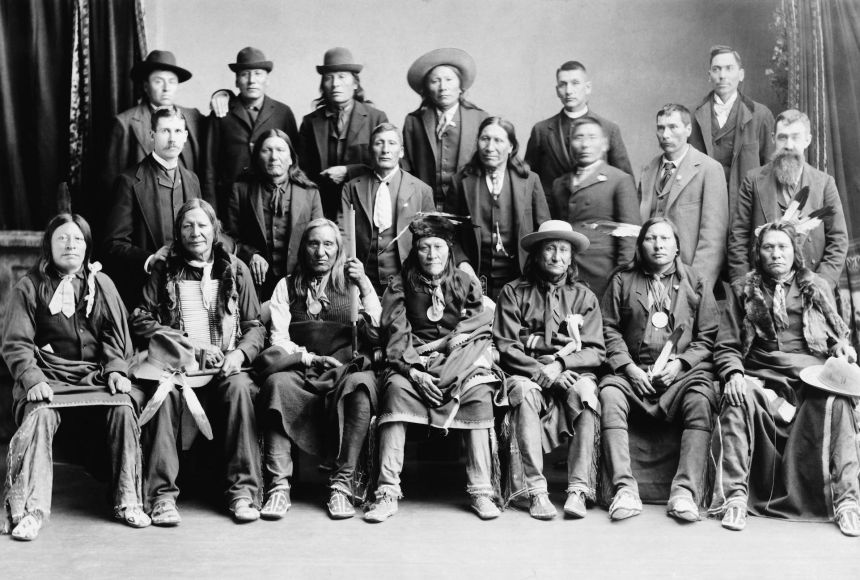The history of relations between Native Americans and the federal government of the United States has been fraught. To many Native Americans, the history of European settlement has been a history of wary welcoming, followed by opposition, defeat, near-extinction, and, now, a renaissance. To Europeans and Americans, it has included everything from treatment of Native American nations as equals (or near-equals) to assimilation to exile to near-genocide, often simultaneously.
Late 18th Century
Many Native American tribes allied with the British during the Revolutionary War. However, the Treaty of Paris, which ended the war, was silent on the fates of these British allies. The new United States government was thus free to acquire Native American lands by treaty or force. Resistance from the tribes stopped the encroachment of settlers, at least for a while.
Treaty-making
After the Revolutionary War, the United States maintained the British policy of treaty-making with the Native American tribes. In general, the treaties were to define the boundaries of Native American lands and to compensate for the taking of lands. Often, however, the treaties were not ratified by the Senate, and thus were not necessarily deemed enforceable by the U.S. government, leaving issues unresolved.
On occasion, the representatives of Native American tribes who signed the treaties were not necessarily authorized under tribal law to do so. For example, William McIntosh, chief of the Muskogee-Creek Nation, was assassinated for signing the Treaty of Indian Springs in violation of Creek law.
Treaty-making as a whole ended in 1871, when Congress ceased to recognize the tribes as entities capable of making treaties. The value of the treaties also came to be called into question when the Supreme Court decided, in 1903, Congress had full power over Native American affairs, and could override treaties. Many of the treaties made before then, however, remained in force at least to some extent, and the Supreme Court was occasionally asked to interpret them.
One notable treaty with ongoing repercussions is the Treaty of Fort Laramie of 1868. Under that treaty, the United States pledged, among other things, that the Great Sioux [Lakota] Reservation, including the Black Hills, would be "set apart for the absolute and undisturbed use and occupation" of the Lakota Nation.
Although neither side fully complied with the treaty’s terms, with the discovery of gold in the area, the United States sought to buy back the Black Hills. The Lakota rejected the offer, resulting in the Black Hills War (1876-1877), which included Custer’s Last Stand at the Battle of Little Bighorn (June 25-26, 1876).
Finally, in 1877, Congress went back on the original treaty and passed an act reclaiming the Black Hills. In 1923, the Lakota sued. Sixty years later, the Supreme Court determined the annulment was a “taking” under the Fifth Amendment and that the tribe was owed “just compensation” plus interest starting from 1877. The tribe has refused to accept payment, however, and is still seeking return of the land. As of 2018, the amount due appears to be around $1 billion.
Removal and Resettlement
Although conflicts were fought in the Northwest Territories (Tecumseh and the Battle of Tippecanoe) and the Southeast (Creek War and the Seminole Wars), the major policy toward the North American tribes in the early part of the 19th century was removal and resettlement.
The Removal Act of 1830 authorized President Andrew Jackson to negotiate for the removal and resettlement of Native American tribes. A primary target was the Cherokee, Creek, Choctaw, Chickasaw, and Seminole from Georgia, Alabama, Mississippi, and Florida. Although the removal and resettlement was supposed to be voluntary, ultimately, this resulted in the series of forcible removals known as the Trail of Tears.
Allotment and Assimilation
For most of the middle part of the 19th century, the U.S. government pursued a policy known as “allotment and assimilation.” Pursuant to treaties that were often forced upon tribes, common reservation land was allotted to individual families. The General Allotment (Dawes) Act of 1887 made this more general, which resulted in the loss of much reservation land.
A new approach was undertaken during the New Deal, under President Franklin D. Roosevelt, with the Indian Reorganization Act of 1934, which ended allotment, banned further sale of Native American land, and returned some lands to the tribes.
After World War II, however, proposals arose in favor of assimilation, termination of tribes, and an end to reservations. A number of reservations, such as the Menominee in Wisconsin and the Klamath in Oregon, had their reservations terminated.
Today
The influence of the civil rights movement in the 1960s led to the Indian Self-Determination Act of 1975, which restored some sovereignty to tribal governments and gave them a certain independence in handling federal funds and operating federal programs.
The status of the Native American tribes with respect to the states is complicated. In general, today’s Native American groups are sovereign within their territory with respect to tribal members, but lack authority over nontribal members.
However, the Supreme Court did determine in 1987 that states cannot regulate Native American gaming enterprises. This resulted in the Indian Gaming Regulatory Act of 1988, which provided the framework that governs Indian casinos.

